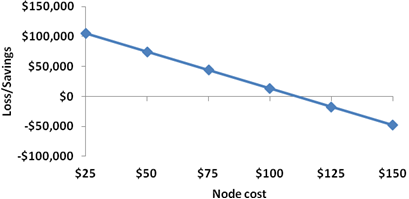The economics of using wireless networks for monitoring traps

Networks of traps cover increasingly large areas (e.g. >26,000ha)
Vertebrate pest control in New Zealand has been evolving over the last decade, from a paradigm of control applied periodically with intervening periods of no control, to essentially continuous control to maintain pest numbers at low levels (presumably below some threshold at which desired values are protected). There has also been a trend towards increasing the scale of control programmes, with some now covering hundreds of thousands of hectares.
This evolution of control programmes has resulted in the increasing use of permanent networks of live- and kill-traps, employing a wide range of trap setting and checking regimes. Irrespective of the implementation details, a common outcome of such programmes is that pest numbers are held at low density, and when checking live-capture traps daily the majority of traps checked are empty. Once a trap network is established (i.e. the initial capital cost is committed), the main cost of running a network is staff or contractor time to check the traps.
Wireless systems have been developed recently to enable a wide range of environmental sensors to be monitored remotely, and, if required, in real- or close-to-real time. Hawke’s Bay Regional Council (HBRC) has been assessing the value of wireless monitoring together with Encounter Solutions, who have developed a system for monitoring traps over larger areas. Bruce Warburton, Chris Jones and Jagath Ekanayake worked with HBRC staff to carry out an economic analysis of the ability of wireless solutions to reduce operational costs, and to identify which critical factors (‘pinch points’) might determine whether such technology is cost-effective.
Live- and kill-traps are set and checked in a wide range of scenarios, and remote monitoring using wireless systems generates few economic benefits for some scenarios and potentially large benefits for others. Rather than simply assume the adoption of wireless technology will provide significant savings to a pest control programme, managers of such programmes need to be aware of the range of scenarios in which wireless systems can be used and, if possible, carry out an economic analysis of any proposed system.
There are three main reasons for checking traps: (1) legal requirements – restraining traps must be checked daily; (2) trap saturation – when more than about 20% of traps are sprung, the capture rate of the trap network declines; and (3) bait replacement – if bait does not have a long field life then all traps need to be visited frequently and rebaited. Bait replacement might also be necessary if bait is taken by non-target species.
One of the scenarios analysed by Bruce and his colleagues was using wireless sensor networks (WSNs) to monitor kill-traps, and they developed a simple spreadsheet economic model to determine which scenarios might have provide savings or losses. The model was based on a scenario that required the trapper to check only those traps that have been sprung when the overall percentage of sprung traps reaches an agreed trigger level. The inputs for the model (see table) were based on a kill-trap network established as part of the ongoing HBRC predator control programme.
Kill-trap economic model input parameters and values based on HBRC’s predator control programme. * A node is the sensor on each trap that signals whether the trap has been sprung or not.** A relay station or hub is a device that takes the signal from the nodes and communicates through the cellular or satellite network to the web, a cellphone or a computer.
| Parameter | Example values |
|---|---|
| Number of traps | 700 |
| Cost of trap node* | $25 |
| Cost of relay station** | $1,000 |
| Ratio of nodes to stations | 700:1 |
| Daily contractor rate | $400 |
| Person days to check all traps | 4 |
| Months to get to 25% of traps sprung | 3 |
| Discount rate | 0.06 |
| Years for depreciation | 5 |
| Months between rebaiting of all traps | 12 |
The model generated savings or losses for various kill-trapping options over a range of parameter values, but for this article only the savings or losses for the parameter values given in the table above are shown, but with node costs of $25, $50, $75, $100, $125 and $150. The model indicated that if nodes cost less than $100 (i.e. the cost of the sensor on each trap), then using a WSN (given the other parameter values in the table) would provide savings (see graph). This model enables each of the parameter values to be varied so each can be assessed for their impact on whether use of the system will provide savings or losses. Further analyses planned include comparing Net Present Values (NPV) of checking traps with and without wireless monitoring.

This work was funded by MBIE and Hawke’s Bay Regional Council.
Bruce Warburton (Landcare Research) warburtonb@landcareresearch.co.nz
Chris Jones
Jagath Ekanayake
